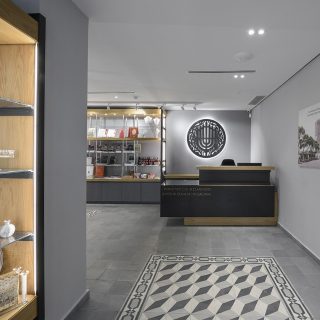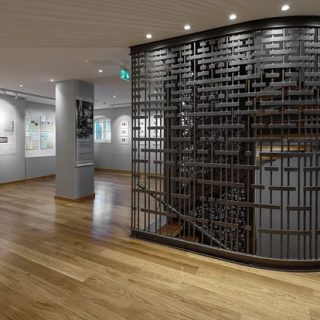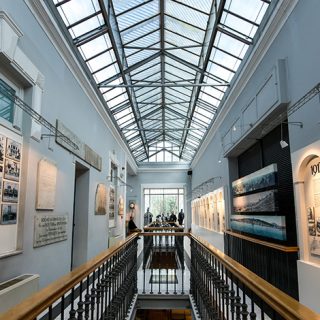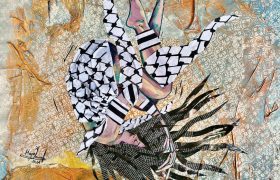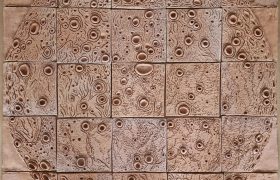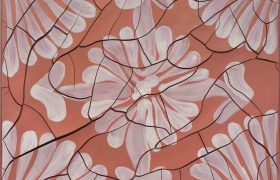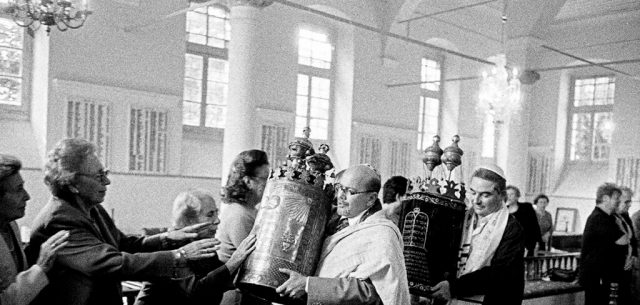The Forgotten History of the Jews of Thessaloniki
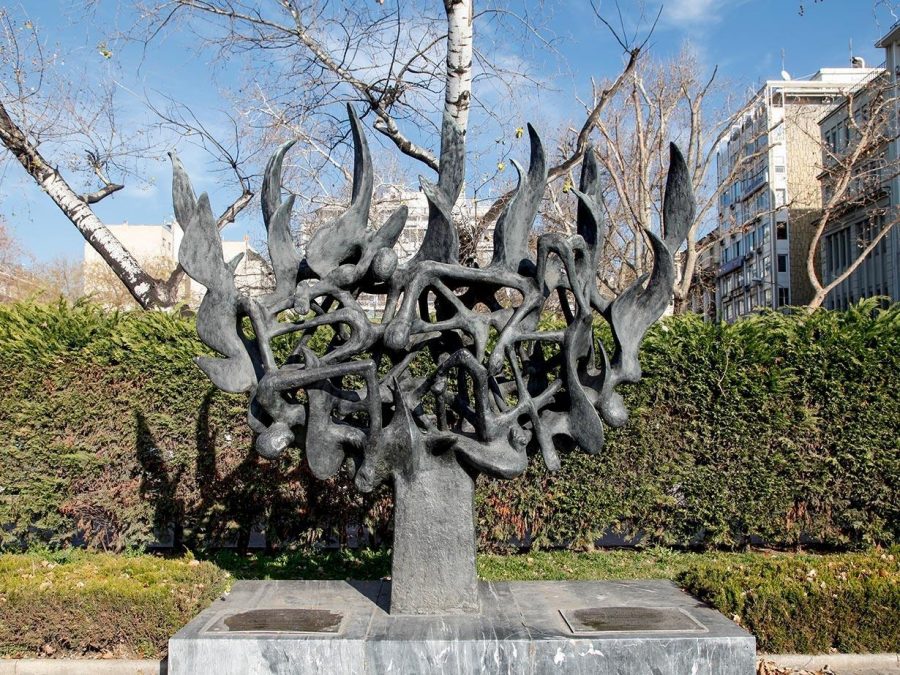
For more than twenty centuries, Thessaloniki gave shelter and a new sense of home for the persecuted Jews of Europe. During the Holocaust, more than 80 per cent of this vibrant Jewish community were exported and slaughtered. Insider revives the rich legacy of a forgotten people.
As the city of Thessaloniki remembers and mourns for the loss of 20% of its population, Insider takes a look at the rich history of a forgotten people. For more than twenty centuries, Thessaloniki was the shelter for the persecuted Jews of Europe. Uprooted throughout their long history from other historical centres of the Diaspora, they were transplanted in this city, creating a large and vibrant Jewish Community, indisputably one of the most important ones in the world, especially during the period 1492-1943. On 27 January 2021, the White Tower in Thessaloniki was draped in the yellow star exactly like the 67.000 Greek Jews and the 6.000.000 Jews of Europe, 78 years ago, who were deported and exterminated during the Holocaust.
Most historians believe that the first settlement of Jews in Thessaloniki who arrived from Alexandria, Egypt, dates back to 140 BCE. The ancient Jewish Community of Thessaloniki constituted a typical example of a Judaic community in a Mediterranean urban center of the Hellenistic and Roman era. Its members were called Romaniotes. They adopted the Greek language, while retaining several elements of Hebrew and Aramaic, as well as the Hebrew script. Apostle Paul visited this community during the early formative years of Christianity. And it is in his travelogue, described in the Acts of the Apostles, that we come across the first written proof of Jewish presence in the city.
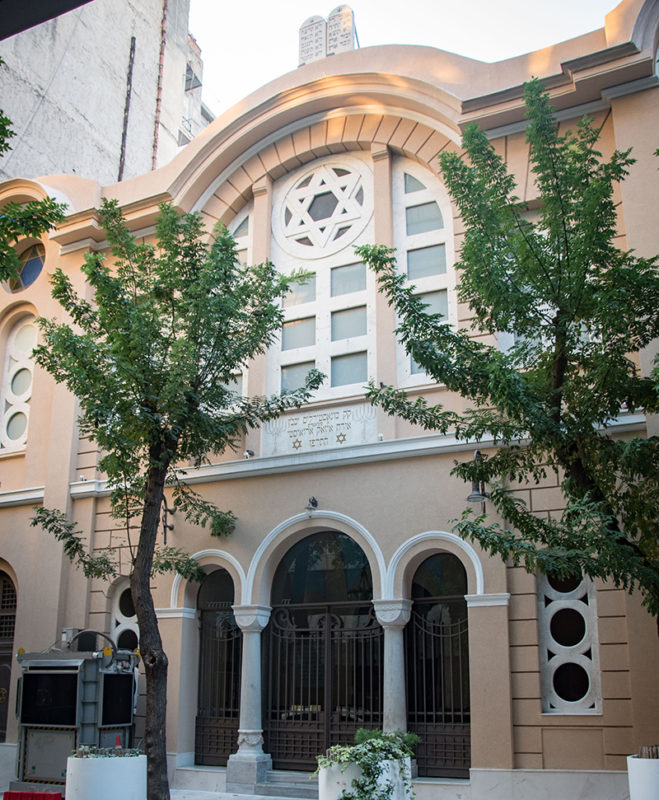 According to tradition, the oldest synagogue in Thessaloniki, where, most probably, Apostle Paul preached, was called “Ets Ahaim” (The Tree of Life). During the Ottoman era and until the 1917 fire, it was located approximately at the intersection of the present-day Kalapothaki and Dimosthenes streets, near the city port.
According to tradition, the oldest synagogue in Thessaloniki, where, most probably, Apostle Paul preached, was called “Ets Ahaim” (The Tree of Life). During the Ottoman era and until the 1917 fire, it was located approximately at the intersection of the present-day Kalapothaki and Dimosthenes streets, near the city port.
During the Roman era, the Jews of Thessaloniki enjoyed wide autonomy. Later, after the East – West division of the Roman empire, certain Byzantine emperors cast their eyes on the Jews, imposing special taxation and/or restrictive measures on religious freedom and worship. A few attempts at forced conversion did not produce appreciable results, since even the ecumenical synods disapproved of the practice, stating repeatedly that Jews had the right to live in freedom and according to the laws and traditions of their religion.
Mid-Byzantine Thessaloniki flourishes inspite of wars in the region, as well as the successive raids of the Slavs and Bulgarians. Its population exceeds 100,000 inhabitants in the middle of the 12th century. Around that time (1159), Rabbi Benjamin of Tudella departs from Saragossa, Spain on a long journey that will last more than 13 years. Upon arriving at Thessaloniki he notes : “After a two-day sea voyage, we arrive at Thessaloniki, a big coastal town, built by Selefkos, one of Alexander’s four heirs. Five hundred Jews live here, headed by Rabbi Samuel and his sons, well known for their scholarship. Rabbis Sabetai, Elias, and Michael also live there, as well as other exiled Jews who are specialized artisans.
During the two following centuries, Thessaloniki was plagued by many misfortunes: its siege and destruction by the Normans (1185), its conquest by the Franks of the Fourth Crusade, and its subsequent occupation, first by the Epirus Principality (1244), and then by the Empire of Nikaia (1246).
Raids by Serbs, Bulgarians and Catalans followed, as well as the Zealots uprising (1342 -1349), and its first conquest by the Turks (1387).
It is during that time (1376), that the first settlement of Ashkenazi Jews takes place in Thessaloniki. They arrive, persecuted, from Hungary and Germany, throughout the 15th century.
A small group of Jews from Provence will settle in Thessaloniki in 1394, while during the period of the Venetian rule (1423 – 1430), large numbers of Jews from mainland Italy and Sicily will also settle here, establishing new synagogues and creating, in turn, their own distinct communities.
In the early morning hours of Sunday, March 26, 1430, the army of Sultan Murat II appears before the city gates. Thessaloniki will capitulate after a three-day siege. Generalized looting, massacres, enslavement and deportations occur, perpetrated by the invading troops. Murat II will be forced to personally intervene, on behalf of the population, in order to put an end to the bloodshed. He will personally set free, at his own expense, many prisoners, and he will take measures for the revival and re-population of Thessaloniki. To that end, he will resettle into Thessaloniki, Turks from Yiannitsa, as well as Christians to whom he grants certain privileges such as communal autonomy and various tax exemptions.
All of the above can be considered as pre-history of the Jewish presence in Thessaloniki. The pivotal point is the settlement of 15,000 – 20,000 Spanish (Sephardic) Jews after 1492, who will make a lasting and seminal contribution to the destiny of the Jewish Community, but also to that of the city as a whole. Those persecuted Jews found shelter in the capital of Macedonia, thus giving her a new profile for the future.
The event that sealed the fate of Spanish Jewry was the Reconquista, i.e. the bloody, step-by-step recovery of the Iberian peninsula into Christian hands, at the expense of the Arabs who were entrenched there since the beginning of the 8th century. The end of the Reconquista occurs on January 2, 1492, when the Arab state of Granada is conquered and dissolved forever. It is then that the political and economic circumstances that had in the past dictated the official policy of tolerance towards minorities and the absence of preferential treatment based on race or religion, seized to be operative, and that policy was immediately reversed. Ferdinand and Isabella now become “Catholic Kings” exclusively, whereas during the war years, they wished to be called King and Queen of three religions.
Thus dawns 1492, the fateful year for the Spanish Jews. A royal edict on March 13 of that year, forces all Jews to either convert to Christianity, or leave the country by the coming August at the latest. It is estimated that around 50,000 Jews were nominally baptized and remained in Spain. The rest, more than 250,000 strong, opted for the road to exile. Some went north, to France, England, the Netherlands. Others chose Italy or Northern Africa. However, the majority settles in areas under Ottoman jurisdiction.
Sultan Vayazit II, at the instigation of Chief Rabbi of Istanbul, Eliyia Kapsali, allowed their entrance into the realm, and ordered local commanders to extend a cordial and warm welcome, and to help them settle down.
Thus, the Spanish Jews, the Sephardim, will settle in all the large urban centers of the Ottoman Empire. Most of them, around 20,000, will prefer Thessaloniki, which still hadn’t recovered from the destruction incurred during its conquest by the Turks. Maybe they were attracted to the city’s strategic location as a key port in the Eastern Mediterranean. Alternatively, they may have been encouraged by the Sultan, seeking to re-populate the deserted city with a fresh, dynamic, urban population.
With their arrival, the deserted city wakes up from its torpor and gradually becomes again a first class financial center, comparable to that of the Roman and Byzantine years. The Sephardim gave commerce a new push, and exploited the mines of the Gallikos river and those of Sidirokapsa. The first printing shop in Thessaloniki, around 1510, was established by the immigrants.
- ©The Jewish Museum of Thessaloniki
The century that followed the expulsion from Spain is also a cultural golden era. Thessaloniki becomes an important center of theological studies, attracting students from around the world, while giving rise to scholars of high repute, such as Rabbis, poets, physicians. Their reputation will spread across Europe. It is during that era, in 1537, that Thessaloniki will be honored with the title “Mother of Israel”, by Samuel Usque, the Jewish poet from Ferrara.
The fame of the community will attract other persecuted Jews who will seek refuge in its welcome embrace. Jews from Sicily and Italy, also persecuted by Ferdinand and Isabella, will follow the exiles of 1492.
Emmanuel, King of Portugal, will follow the example of Ferdinand and Isabella, a few years later. On December 5, 1496, he orders the Jews of Portugal to either convert or leave. The Exodus of the Portuguese Jews starts at the end of October 1497, and a large number head towards Thessaloniki. However, even the ones nominally baptized who stayed behind, the so-called Conversos or Maranos, will be forced into exile during the period between 1536 and 1660, victims of the “purity of blood” ideology (“limpieza de sangre”).
New waves of refugees arrive during the 16th century, coming from Provence, Poland, Italy, Hungary, and Northern Africa. “Until the end of the 17th century, it was very rare for a ship to dock at the Thessaloniki seaport without disembarking a few Jews”, writes P. Risal (J. Nehama).
Thus, Jews will prevail in numbers. In 1519, according to Ottoman archives, 1,374 Muslim families, along with 282 singles, in all 6,870 persons, inhabited Thessaloniki. The Christian population is comprised of 1,078 families along with 355 singles, to a total of 6,635 persons. The Jews number 3,143 families together with 530 singles, or approximately 15,715 persons.
The Jews will settle in the almost deserted neighborhoods of the area below Egnatia street, spanning the length from the Vardar square to the current Diagonios (crossroads of Tsimiski and P.Mela streets). Ottoman files record 16 Jewish neighborhoods since the beginning of the 16th century. There, the Jews will congregate separated into autonomous communities according to their place of origin.
The center of each community is the synagogue. In fact, it is not only a religious and administrative center, but also an indication of the tendency of each group of immigrants, to preserve its individuality and autonomy with respect to each other. However, the fluidity of the dividing lines between the communities, as well as the business activities that some of them undertake from the beginning of the 16th century onwards, and particularly in textile manufacturing, give birth to intense political infighting. The quarrels manifest themselves especially at times such as the election of the Rabbi or secular administrators, or when some notables seek to arbitrarily impose their own opinions.
Furthermore, the increasing business activities, as well as the fact that the various communities have to deal with the Turkish authorities, give rise to a growing need for a common front. Thus, the seed of the union of the independent synagogue / communities into one federation is planted. This federation is loose in the beginning, but gradually, conditions dictate a closer cooperation. An offspring of this unifying trend is the joint establishment of the “Talmud Torah a Gadol” synagogue-school, in 1520.
Sixteenth century sources inform us that light industry, especially textiles, is the main occupation of the majority of the Jewish population of Thessaloniki. The Jewish immigrants imported production know-how and methods previously unknown in the region.
From 1515 onwards, the Ottoman State covers all its requirements in textiles for army uniforms from Thessaloniki Jewish textile manufacturers. Furthermore, it is agreed that, using these products as a medium of exchange, the poll tax levied on the community members, is paid in kind. Starting in 1540, the synagogues become themselves producers, employing their poor members as salaried workers. The profits from these business ventures are used for the maintenance of their charitable and educational institutions.
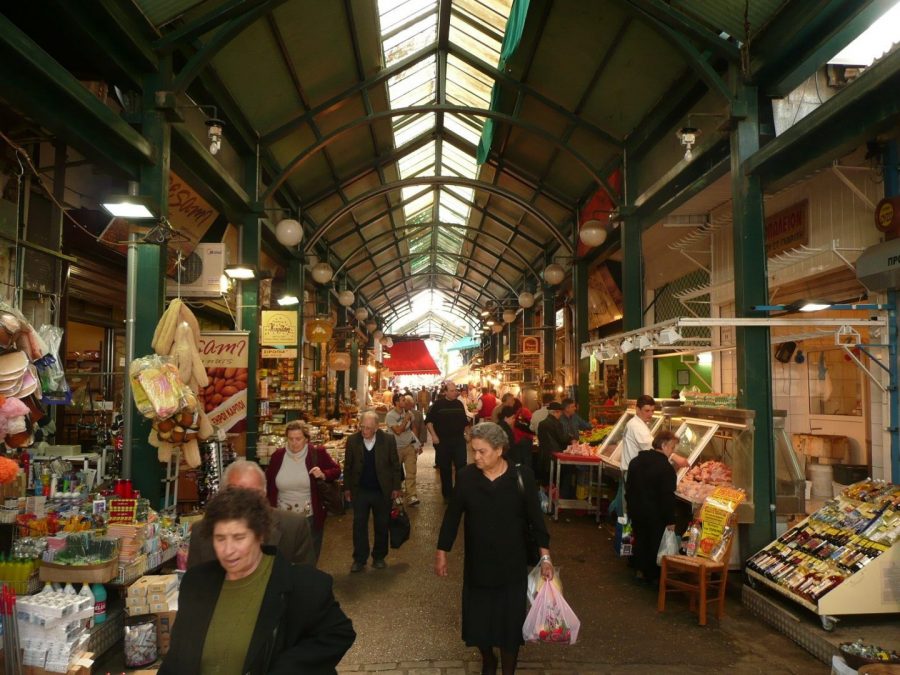
In 1568, a Community delegation to Constaninople, under the leadership of Moshe Almosnino, succeeds in securing a new Sultan edict, reconfirming all the written privileges that were initially granted by Suleiman the Magnificent and were burned during the fire of 1545. Thereafter, the Jewish Community of Thessaloniki is treated as “Musselnik”, i.e. an autonomous administrative unit, reporting directly to the Sublime Porte. It also secures the right to acquire raw materials at prices lower than market prices.
Thus the Jews of Thessaloniki will enjoy a period of prosperity, that will not be curtailed before the beginning of the 17th century, with the discovery of the new sea routes, the decline of Venice, and the involvement of the Ottoman Empire in a succession of destructive military campaigns. As a consequence of the economic malaise, cultural decline will follow. It is during this period that biblical studies will decline in favor of mysticism in the form of the study of the Cabbala.
It is within this setting of mysticism and spiritual turmoil that Sabbetai Sevy of Smyrna (Izmir), appears in 1655 in Thessaloniki, declaring himself to be the long-expected Messiah, self-appointed King of Israel, and savior of the Jewish people. The appeal of his message will worry the Turkish authorities, causing his arrest and condemnation to death in 1666. Sabbetai Sevy is forced to convert to Islam in order to save his life. The Jews had been already split into those who believed in him, and those who considered him a crook and an impostor. The former, around 300 families, will follow him in defection, thus creating the peculiar social minority of “Judeo-Muslims”, that came to be known as “Donmeh”.
This group defection shook the community. Hundreds of families as well as professional guilds were split, making it impossible for the independent community-synagogues to function effectively and cope with the problem. The situation was further aggravated by the economic crisis, hindering the ability of the separate communities to support their cultural and welfare institutions. This gradually set off a process of integration, whereby the individual communities had to relinquish authority and rights to a more centralized federal governing body, in order to achieve better administrative control, and face the new challenges more effectively. Finally, around 1680, the small independent communities formally unite under the leadership of a single council comprised of three Rabbis and seven secular members.
Thus, it is apparent that the Jews managed to maintain their sense of communal organization and solidarity even during those years of material and cultural stagnation caused by the religious strives and divisions, the unfavorable economic circumstances, and the oppression of the Yenitsars.
The Community will emerge from this “Middle Age” era to its Renaissance, around the middle of the 19th century. Material well-being and cultural awakening go hand-in-hand, influenced by the European Enlightenment, the Industrial Revolution, and the neocolonial campaigns of the European powers towards the East. The new trends and ideas take shape in the “Haskala” movement among the Jews, with intellectual ventures beyond the narrow confines of the biblical and post-biblical tradition, and towards the study of contemporary secular thought and art. This process of emancipation is further assisted by the new sociopolitical conditions prevailing in the Ottoman territories as a result of the Porte’s attempt to move away from medieval despotism, towards a new, modernized image. The Yenitsar body is dismantled in 1826, while for the first time, some civil rights are being granted to the non-Muslim constituents of the Empire, with the edicts (firmans) of Hati Humayan and Giulhade(1836 and 1854).
The increasing appearance of western industrial products will also contribute to the city’s overhaul and expansion, transforming it into a city-agency of commerce and industry. Part of the Byzantine fortifications are torn down in 1869. The fires of 1890, 1896, and 1898 will offer the opportunity for an urban transformation. The burned down districts are being redesigned, narrow streets are widened, fresh running water is being introduced along with electricity and the streetcar, as well as the railroad, which, from 1871 onwards, will connect Thessaloniki with Constantinople to the East, and Europe to the West. New infrastructure works at the port are being inaugurated, modern banking institutions open to the public, and in 1854, the first modern industrial complex is created : the Allatini flour mill, owned by the Allatini family, Jewish immigrants from Italy. Jews own 38 out of the 54 commercial enterprises of the city, and constitute the overwhelming majority of its workforce.
Even though Thessaloniki retains its multinational structure, the demographic and financial superiority of the Jewish Community, will constitute one of its more distinct features. By the end of the 19th century, Thessaloniki will number more than 70,000 Jewish souls, i.e. about half of the total population.
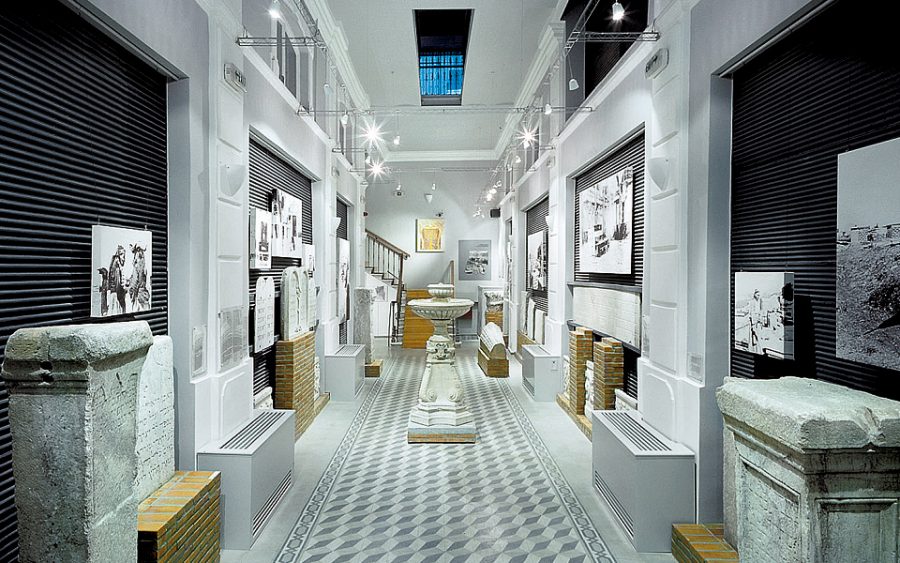 Education is reformed with the modernization of dozens of district schools and the traditional “Talmud Torah” school, and with the inauguration of the “Alliance Israelite” school in 1873. Jewish children constitute the majority within the numerous foreign schools. The Community will receive thousands of refugees, victims of pogroms in Czarist Russia, in 1891, housing them, along with the victims of the fire of 1890 (and later the fire of 1917), in the newly created neighborhoods of Baron Hirsch, Kalamaria, Rezi Vardar, etc. The first two above mentioned districts constitute the first attempt at modern city planning in Thessaloniki.
Education is reformed with the modernization of dozens of district schools and the traditional “Talmud Torah” school, and with the inauguration of the “Alliance Israelite” school in 1873. Jewish children constitute the majority within the numerous foreign schools. The Community will receive thousands of refugees, victims of pogroms in Czarist Russia, in 1891, housing them, along with the victims of the fire of 1890 (and later the fire of 1917), in the newly created neighborhoods of Baron Hirsch, Kalamaria, Rezi Vardar, etc. The first two above mentioned districts constitute the first attempt at modern city planning in Thessaloniki.
It is also interesting to note that the first newspaper to circulate in Thessaloniki in 1864, is the Jewish “El Lunar”. “La Epoca” will follow in 1875 and, later, “La Imparciale”, “Le Progrons”, “Journal de Salonique”, “La Libertin”, Opinion”, L’Independant”, the Zionist “La Nation”, “El Avenir”, “Renacencia Judia”, “La Esperanza”, “Pro Israel”, and others.
In 1908, the “Young Turks” launch their coup in Thessaloniki, and, using the city as their base, overthrow Sultan Abdul Hamit II.
Following the Young Turk revolution, the Zionist movement surfaces in Thessaloniki with the creation of the “Bnei Zion” society, and the “Maccabi” athletic association. Zionism had first appeared in the city in 1899, operating under the cover of societies such as “Kadima”, which had as its stated purpose the dissemination of the Hebrew language.
Around the same time (1909), from the midst of the populous Jewish working class of Thessaloniki, the socialist workers’ federation is born, better known by its Ladino (Judeo-Spanish) name of “Federation”, that will function independently until 1918, when, merging with other Greek leftist organizations, gave birth to the Socialist Workers’ Party of Greece. The founder and leader of “Federation” was Avraam Benaroya.
On October 26, 1913, Thessaloniki was incorporated once again into the Greek state. The Community leaders were immediately received by King George I, who promised full equality for the Jews, a promise subsequently reconfirmed and proven in practice. Thus, the attempts of the Bulgarians to win over the Jews, to compensate for their lack of a sizable ethnic base in the city, is unsuccessful.
As a consequence, many Jews were forced to emigrate during the inter-war period, especially after the regrettable incident of the Campbell neighborhood arson, by ultra-right extremist elements (1931). A large proportion of them settled in Palestine. Nevertheless, the Community will number more than 50,000 souls on the eve of World War II. The Jews of Thessaloniki live in harmony, side by side, with their non-Jewish compatriots and fulfill their duty towards the Greek motherland during the 1940-41 war: 12,898 Jews served in the armed forces (343 officers among them). Their losses mount to 513 dead and 3,743 wounded
Conversely, the Greek administration increasingly wins the confidence of local and international Judaism, who reciprocate by openly supporting the Greek claims in the partition of the European part of the disintegrating Ottoman Empire, after the Balkan wars.
Thus, the new period of integration into the Greek state started for the Jews. The first post-liberation decade which was marked by national tribulations such as political divisions, the great fire of August 1917, and the Asia Minor catastrophe, will close with the massive influx of ethnic Greek refugees from Turkey. The fire of 1917 was a particularly severe blow, from which the Community was never able to fully recover : 53,737 Jews were rendered homeless, and many buildings were destroyed, including the Community administrative offices, those of the Chief Rabbinate and of various welfare institutions, as well as thirty synagogues, the school of the Alliance Israelite, and ten more schools. As a consequence, many Jews were forced to emigrate during the inter-war period, especially after the regrettable incident of the Campbell neighborhood arson, by ultra-right extremist elements (1931). A large proportion of them settled in Palestine. Nevertheless, the Community will number more than 50,000 souls on the eve of World War II. The Jews of Thessaloniki live in harmony, side by side, with their non-Jewish compatriots and fulfill their duty towards the Greek motherland during the 1940-41 war: 12,898 Jews served in the armed forces (343 officers among them). Their losses mount to 513 dead and 3,743 wounded. The occupation of Greece by the Axis forces will mark the beginning of the end.
The Holocaust
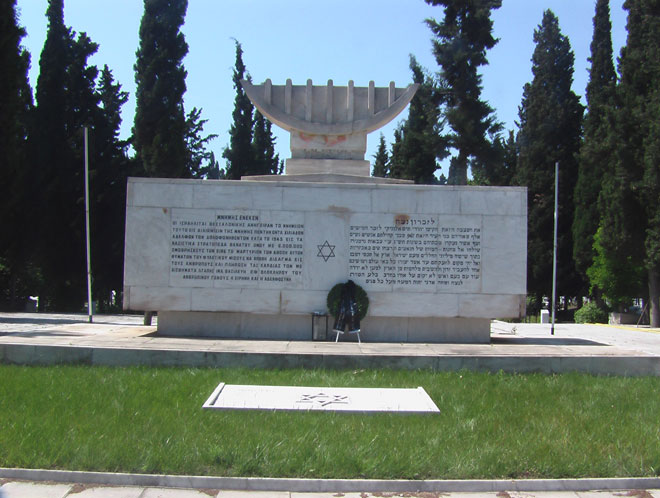 The Germans enter Thessaloniki on April 9, 1941. A few days later Jews are banned from cafes, pastry shops etc. The Germans imprison the members of the Community Council, order the Jews to turn in their radio sets, occupy the Hirsch hospital, as well as many Jewish-owned houses, and loot the Community offices and the richest Jewish libraries.
The Germans enter Thessaloniki on April 9, 1941. A few days later Jews are banned from cafes, pastry shops etc. The Germans imprison the members of the Community Council, order the Jews to turn in their radio sets, occupy the Hirsch hospital, as well as many Jewish-owned houses, and loot the Community offices and the richest Jewish libraries.
On July 11, 1942, all Jewish men aged 18 to 45, are ordered to report at Liberty square. There, after being subjected to indescribable humiliations, they are registered and taken away for forced labour. The Community had to pay the huge sum of 2.5 billion drachmas to the Germans, in order to set them free. By the end of the same year, the Germans will confiscate the thriving Jewish enterprises and desecrate and destroy the immense, 2,000-year old Jewish cemetery of the city.
On February 6, 1943, an SD committee (Sicherheitsdienst-security service of the German Reich) arrived in Thessaloniki. It was headed by SS-Hauptsturmfuehrer Dieter Wisliceny and SS-Obersturmfuehrer Alois Brunner (SS captain and first lieutenant respectively). This delegation put in motion the mechanism for the final annihilation of the Jews : they were forced to wear the yellow star of David, according to the Nuremberg Laws of 1935, and to live only in designated neighbourhoods (ghettos). The use of public telephones and transportation was prohibited. Disguising their true intentions, and using Chief Rabbi Koretz as their instrument by appointing him president of the Community, the Germans claim that their end goal is the restructuring of the Community into a self administered entity, located in an autonomous area within the city, with its own mayor and Chamber of Commerce. They also appoint a Jewish Militia (Juden Ordnungspolizei), and Jewish citizens are ordered to fill out detailed questionnaires about their assets.
On March 6, 1943, the German occupying authorities prohibit the exit of the Jews from the Ghetto confines, while at the Baron Hirsch neighborhood (thereafter a transit camp), the stage for the final act of the tragedy is being set. It is there that the human herds will be lead, ready to be delivered for slaughter. The first rail convoy departs on March 15 for the extermination camp of Auschwitz / Birkenau. Consecutive convoys, a few days apart from each other, will carry in a few weeks time, the Jews of Thessaloniki, piled in cattle rail cars, to their place of extermination.
The Church, the National Resistance movement, and the State Police set the example of offering sanctuary to many Jews, followed by ordinary people offering help and shelter whenever possible, revolting in horror to the crime being committed, even though, at that time, nobody – not even its very victims – could grasp its actual magnitude. The Metropolitan See of Thessaloniki, Gennadios was vocal against the deportations, and an official letter of protest, signed in Athens on March 23, 1943, by Archbishop Damaskinos, along with 27 prominent leaders of cultural, academic and professional organizations demonstrated the Greek Church’s solidarity with the Jewish people. The document, written in a very sharp language, refers to unbreakable bonds between Christian Orthodox and Jews, identifying them jointly as Greeks, without differentiation. It is noteworthy that such a document is unique in the whole of occupied Europe, in character, content and purpose.
Out of the 46,091 Jews that were deported to the extermination camps, only 1950 returned alive, i.e. approximately 4%. The first post-war years were particularly harsh: the survivors encountered readjustment problems, mainly with respect to health care and the coverage of their basic economic needs. Quite a few emigrated to the USA and to Israel. The rest tried to build a new life on the ruins of the Holocaust. Today, half a century after the irrevocable disaster, Thessaloniki numbers no more than 1,200 Jewish souls.
The Community maintains two synagogues, a communal center hosting recreational, religious, literary and artistic events, a primary school, an old-age home, a museum, and a summer youth camp. The Community is still prominent in the financial, social and cultural life of the city. Furthermore, the Community financed on its own the construction and dedication of the “Hellenic House” at the Hebrew University in Jerusalem, a project for which it was honored with an award by the Academy of Athens. The Municipality of Thessaloniki rewarded the Community for its wide-ranging and long-standing contribution to the city, by dedicating, in 1986, a city square to the memory of the victims of the Holocaust.
Thus, the Jewish Community of Thessaloniki managed to emerge from the horror of the Holocaust, however decimated, and to keep on constituting an important element of the cultural and economic life of the city, setting an example of vitality, tenacity, and intellectual strength.
SYNAGOGUES
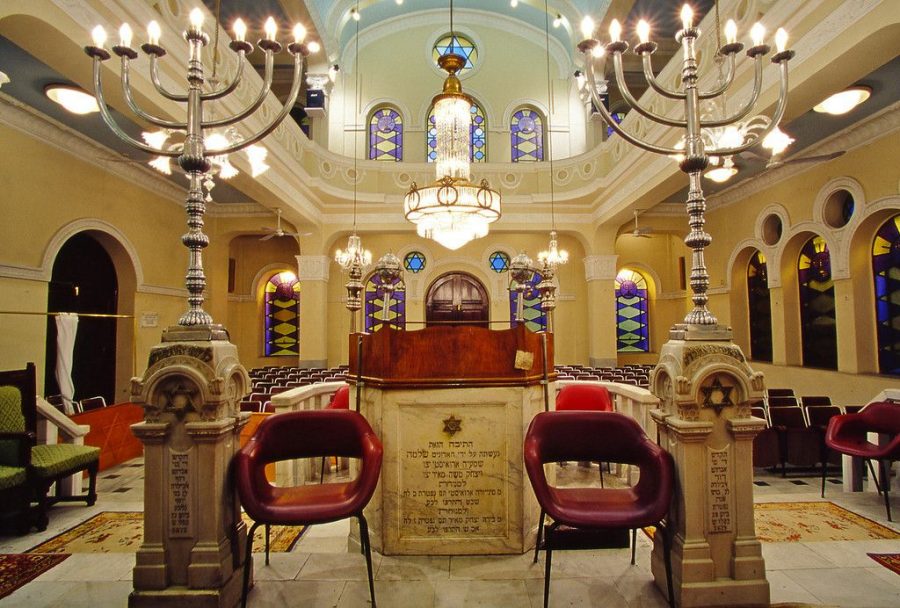 The Monasteriotes’ Synagogue
The Monasteriotes’ Synagogue
The Synagogue of the Monasteriotes was founded with a donation by Ida Aroesti to the memory of her husband Isaac. Families from Monastir in Yugoslavia who had settled in Thessaloniki after the Balkan Wars (1912-1913) and World War I (1914-1918), also contributed to the Synagogue’s building and furnishing.
The foundations were laid in 1925 and construction lasted two years. The Synagogue was officially dedicated by the Ghief Rabbi of Thessaloniki Chaim Raphael Habib on 27 Elul 5687 (1927).
During the Nazi occupation the Monasteriotes’ Synagogue was the center of the ghetto that was created in the inner city. When the entire Jewish population was deported to the death camps, the Synagogue was used by the Red Cross as a warehouse, thus avoiding destruction by the Nazis.
Immediately after the liberation in November 1944, the few Jews that had been saved by Christian friends and those who had joined the National Resistance Forces found refuge in this Synagogue. When normal Community life was restored it became the central Synagogue of Thessaloniki.
In June 1978 the earthquake that shook the city caused extensive damage to the building and its services were suspended until the delicate task of its restoration was completed, with funds provided by the Greek Government that considered it as one of the historical monuments of Thessaloniki. Today it is in operation for the religious needs of the Thessaloniki Jews.
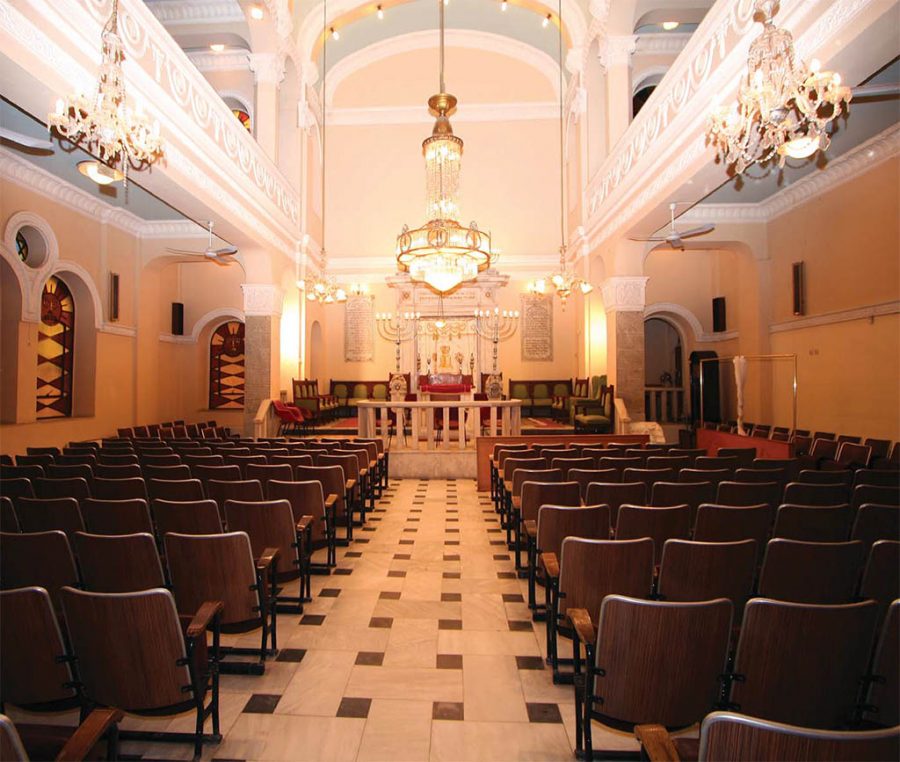 Yad Lezicaron” Synagogue
Yad Lezicaron” Synagogue
This Synagogue was opened in 1984, dedicated to the memory of the victims of the Holocaust. It was built on the site of the small “Bourla” prayer house (Caal de la Plaza) that had been operating since 1921 to meet the religious needs of the numerous Jews who worked in the nearby market place.
“Yossua Abraham Salem” Synagogue
There is also a small synagogue in the Old People’s Home for their religious needs.
The New Jewish Cemetery
The Nazis destroyed the ancient Jewish cemetery of Thessaloniki that covered about 300,000 sq. m. in the area where the University Campus is situated today. The graves were looted and tombstones were scattered all over the city.
After the liberation, the Community founded a new cemetery in the Stavroupolis area. Some tombstones from the old cemetery were carried there and a memorial to the victims of the Holocaust has been erected
PLACES OF JEWISH INTEREST
Villa Fernandez” (Casa Bianca)
(At the corner of Vassillissis Olgas and Th. Sofouli Str.) Built in 1910 by the Italian architect Pierro Arigoni as a residence of the Jewish businessman Dino Fernandez, it has since been associated with the romantic involvement of his daughter Aline with Lieutenant Aliberti
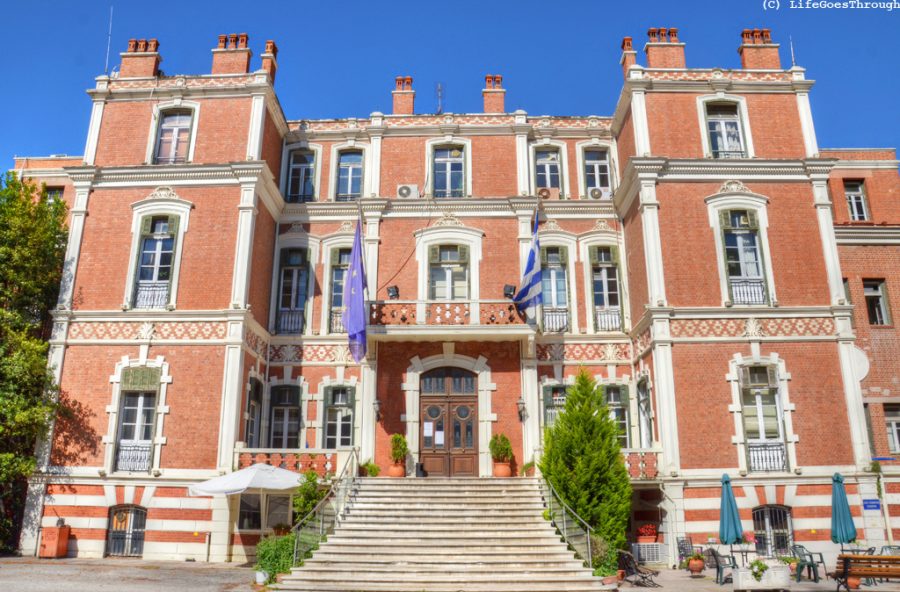 Villa Allatini
Villa Allatini
(198 Vassillissis Olgas Str.)
It was built in 1888 as the summer residence of the Allatini family, a family famous for both its business and community activities, by the Italian architect Vitaliano Pozelli.
Between 1909 and 1912 it was used as the prison-residence of Abdul Hammid II, who was overturned by the Young Turks. In 1926 it hosted the newly founded University of Thessaloniki while during the 1940-41 War it was used as a hospital. Today, Villa Allatini houses the Prefecture of Thessaloniki.
Other monumental buildings that belonged to the Allatini family and are still in use today are the mills on Antheon Str. and their Bank on Stock Market Square.
Villa Mordoch
(162, Vas. Olgas Str.)
Built by the Greek architect Xenophon Paeonides in 1905 as a residence of the Turkish Division Commander Saifulah Pasha. In 1923 it was bought by the Jewish family Schialom and in 1930 by another Jewish family, the Mordochs. After World War II it housed successively the services of ELAS, the 3rd Army Corps headquarters, and the Social Security Institution of the City of Thessaloniki. Today it is used by the Municipality of Thessaloniki as an Exhibition Hall for paintings.
Villa Modiano
(68, Vas. Olgas Str.)
It was built in 1906 as the residence of Jacob Modiano by the engineer Eli Modiano. In 1913 the villa was bought by the City of Thessaloniki and offered as a palace to King Constantine. It was used in the inter-war period as the residence of the Governor General of Macedonia, and it later housed the Military School of Medicine. Since 1970 it has been housing the Macedonian Popular Art Museum.
The picturesque Modiano Market, the “Saul Modiano Arcade”, the Hippocrates Hospital, built in 1907 by the Jewish Community with the financial support of Baroness Clara de Hirsch, and finally “Yenni Djami” built in 1902 by the “Donmehs” (Jews who had converted to Islam in the 17th century) and used later as Thessaloniki’s Archaeological Museum. Since the completion of the new Archaeological Museum, Yenni Djami has been used for painting and sculptures exhibitions.
Τhe Museum
The Jewish Museum of Thessaloniki was founded to honor the rich and creative Sephardic heritage as it evolved in the city after the 15th century. Consequent to the horrible expulsion from Spain by Ferdinand and Isabella in 1492, Jews began to arrive in the safe haven of the city in big numbers bringing with them an awareness of Renaissance culture and languages of the Western Mediterranean. Skills such as printing, cartography, medicinal sciences and knowledge of contemporary weaponry made the Iberian Jews an asset to the Ottomans. Rabbinical homilies and commentaries also accompanied the emigrants including the main cabbalistic works that were rooted in the Jewish mystical tradition of Gerona.
The creative impetus of the Sephardi settlers was to bring about the eventual founding of some thirty two Kehiloth -communities- each with its own synagogue, traditions and unique customs, bearing the names of places of origin in Spain, Portugal and Italy.Very rapidly, Sephardic creativity in Thessaloniki reached high point in the 16th century. The city provided a climate of tolerance and economic stability; it was not by chance that Thessaloniki was also known as Madre de Israel, Mother of Israel.
In academies associated with these synagogues, rabbis and mystics continued to teach the great traditions of Iberian Jewry. In the course of the following centuries, the small Jewish cemetery of the city was enlarged to accommodate the increased numbers of the deceased. By 1940 there were more than 500,000 tombs.
The Museum is housed in one of the rare Jewish structures that survived the fire of 1917. Located in the very heart of Thessaloniki, this imposing building has at times housed the Bank of Athens and the offices of the Jewish newspaper L’ Independent and is a silent witness to the great Jewish presence that once filled its streets with the language of Cervantes, redolent with the odours of the kitchens of Seville and Toledo, silent from Friday to Saturday during Shabbat. The 19th and early 20th centuries were to see some of the early conditions conducive to the growth of the Jewish community reversed by wars, revolts and the possibility of new horizons in Europe, Asia and the Americas for more imaginative and innovative Jews. At the same time, a new challenge appeared after the absorption of Thessaloniki into the Greek State in 1912, in the need to accommodate Jewish life to the demands of current nationalism. As if to exacerbate the new conditions, a great fire in 1917 destroyed most of the Jewish Quarter in the heart of the city. In 1941, Thessaloniki under the Nazis, with its community of some 49,000 Jews, was ill prepared for the horrors of the Final Solution.
By the end of 1945, only a handful of Jews remained; 96,5% of the Jewish Community of the city was exterminated in the death camps of Poland.
The Jewish Museum of Thessaloniki has evolved out of this complicated matrix of historical circumstances. It is but one of several endeavours created within the structure of the Jewish Community of Thessaloniki in a building renovated by the Cultural Capital of Europe Organization . The Museum incorporates artifacts from its permanent collections, photographic exhibitions and the Simon Marks Photographic Exhibition.
On the ground level are monumental stones and inscriptions that were once found in the great Jewish necropolis that lay to the east of the city walls. Accompanying these stones are a series of photographs showing the cemetery and visitors as it was in 1914.A research and documentation center operates within the premises, which aims to document and digitize archival documents from the Museum’s own collection as well as archival material from other sources, thus creating a database accessible to visitors.
Central to the first floor is a narrative history of the Jewish presence in Thessaloniki from the 3rd century BCE until the Second World War. This exhibit was designed at the kibbutz Beth Lohamei Ha-Gettaoth in Israel and its reproduction in Thessaloniki was funded by “The Michael Marks Charitable Trust”.
Complementing this exhibition, are many artifacts from the collections of the Museum, giving the visitor the chance to have an image of religious and everyday life of the pre-war Jewish Community of Thessaloniki.
A separate exhibit focuses on the Shoah, as it affected the Jewish Community of Thessaloniki. The majority of the community – some 49,000 persons – was systematically deported to Auschwitz and Bergen-Belsen where most of them perished.
The library houses important texts that were printed in Thessaloniki from the 16th to the 20th century, covering almost every aspect of Jewish life, religious and secular. The library acts also as a repository for books on the history, customs and language of the Sephardi Jews. Adjacent to it is an audio-visual centre, in which visitors will be able to watch and research tapes and films documenting Jewish history -especially on the Holocaust.
The Museum provides special educational programs for schools.
OPENING HOURS
Tuesday, Friday & Sunday: 11:00am – 2:00pm
Wednesday & Thursday: 11:00am – 2:00pm & 5:00pm – 8:00pm
JEWISH COMMUNITY OF THESSALONIKI
Jewish Museum of Thessaloniki
13, Agiou Mina Street, 546 24 Thessaloniki, Greece
Tel.& Fax: +30 2310 250406-7, e-mail: jctmuseo@otenet.gr

